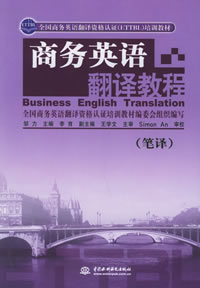A Journey into Chinese-English Environmental Translation
作者:古龙 2009-07-04




语际翻译公司 转载请注明https://www.scientrans.com
∗本栏目部分文章内容来自互联网,部分已经过本站编辑和整理,如有版权事宜请联系Email/MSN jesczhao@hotmail.com
Pitfalls can also arise when a compound word or phrase is provided with the full literal translation, but, in the target language, a part of that compound is not usually associated with the other part. An example is with shengtai huanjing. Again, most dictionaries provide the literal translation, "ecological environment", which is not an unused or impossible combination in English. The problem is that this compound is rarely used as such in English. Usually when we speak of the "environment", we are talking about the "ecological environment": there is no need to add the word "ecological". In Chinese, huanjing can also refer to shengtai huanjing, but the full compound is customarily used, in contrast to the English.
Of course, sometimes the dictionaries don't provide us with the word at all. An example of one word that I cannot find even in large Chinese-only dictionaries is jian, jiandi or huangtu jian. According to the Atlas of Landforms of China (1985), this is a type of shallow valley peculiar to loess regions. A jian may be several hundred metres to several kilometres wide and tens of kilometres long, and has a flat valley floor. It is formed where loess has filled a previous river valley, and is mainly formed in river headwaters in areas not yet reached by headward erosion caused by the modern river (Atlas of Landforms of China 1985). Fortunately, the same reference provides a handy English word for the landform, "loess vale", which seems a reasonable translation. Interestingly, the character for jian has the same pronunciation as another character which refers to ravines or gullies in general.
Another word that has evaded the dictionaries, and which has received some interest in the Chinese media this year, is haizi. To all intents and purposes, haizi refers to a mirage, but the usual Chinese word for mirage is haishi shenlou. Mirages hit the news in the northern coastal city of Dalian this year, when a line of hills, together with several chimneys, mysteriously appeared over the sea near the port. According to a spokesperson from the Dalian Meteorological Observatory, quoted in the Bandao Chenbao newspaper on 31 July 2003, this was a haizi, not a haishi shenlou. What's the difference? asked the baffled reporter. The Observatory spokesperson replied that the cityscape of far-away London appearing in the air over the desert or the East China Sea would be an example of haishi shenlou, whereas an image of an island appearing above the real island would be an example of haizi. Further, haishi shenlou are usually short-lived phenomena, whereas haizi last for some time. I would be curious to know whether haizi is a recently coined word.
Intriguing landforms and local climates
As is apparent above in the discussion on huangtu jian, locally-important landforms can be given names that are very specific to that kind of landform and that region. Since China has such a wide range of landscapes, the language has developed a number of interesting locally-specific or landform-specific terms, some of which, because of their specificity, give rise to difficulties when translating them to another language. For example, southwest China, and Yunnan and Guizhou in particular, has many tectonically-formed basins known locally as bazi. These usually have a relatively flat floor, and are ringed by hills or mountains, often arranged along bounding faultlines. Kunming, the capital of Yunnan, lies in such a basin. The basin is bounded to the west by the dramatic fault scarp of Xishan (the Western Hills), which towers above the expanse of Dianchi, the largest lake in Yunnan. It should be noted that bazi refers specifically to the floor of the basin (i.e. the plain), and does not include the surrounding hills.
The issue of landform naming is also met when discussing the wonderful variety of karst landforms in China, of which the spectacular hills in the vicinity of Guilin, in Guangxi, are the most famous example. Three words are used to describe these hills in Chinese, depending on their arrangement. A single tower or hill is referred to as gufeng, whereas groups of peaks are divided into fenglin and fengcong. The Landform Atlas of China provides a useful translation for gufeng—"solitary peak", and Sweeting (1995) suggests "peak forest" for fenglin and "peak cluster" for fengcong. The Hanyu Da Cidian (Chinese-English Dictionary, 1993 edition) agrees with peak cluster for fengcong, but falls down with fenglin, for which it suggests hoodoo, fungling, or needle karst.
- 相关文章

- 没有相关文章
- 评论
- seme:文章内容文章内容文章内容文章内容文章内容文章内容文章内容文章内容文章内容 章内容文章内容文章内容文章内容文章内容
- seme:文章内容文章内容文章内容文章内容文章内容文章内容文章内容文章内容文章内容 章内容文章内容文章内容文章内容文章内容

- A Journey into Chinese-English Environ…
2009-5-29 11:16:54 - Introduction One of the great pleasures—and occasionally frustrations—in translation is hunti...
期刊征稿
- 第四届IEEE生物信息与生…
2009-6-30 19:42:01 - 基本信息 主办单位: 四川大学,IEEE生物医学工程协会(EMBS) 承办单位 开始日期 2010/06/18 结束日期 截稿日期 2009/1...
- 第九届全国光电技术学术…
2009-6-30 19:35:58 - 基本信息主办单位: 中国宇航学会光电技术专业委员会承办单位 开始日期 2009/11/01结束日期 截稿日期 2009...















